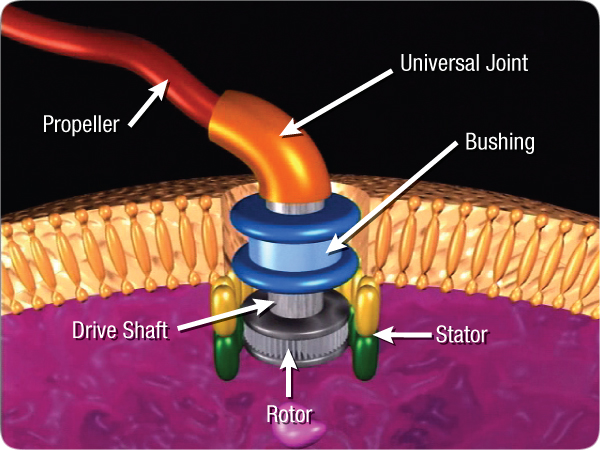Below is the online edition of In the Beginning: Compelling Evidence for Creation and the Flood,
by Dr. Walt Brown. Copyright © Center for Scientific Creation. All rights reserved.
Click here to order the hardbound 8th edition (2008) and other materials.
41. Living Technology
Most complex phenomena known to science are found in living systems—including those involving electrical, acoustical, mechanical, chemical, and optical phenomena. Detailed studies of various animals have also revealed certain physical equipment and capabilities that the world’s best designers, using the most sophisticated technologies, cannot duplicate. Examples of these designs include molecular-size motors in most living organisms;a advanced technologies in cells;b miniature and reliable sonar systems of dolphins, porpoises, and whales; frequency-modulated “radar” and discrimination systems of bats;c efficient aerodynamic capabilities of hummingbirds; control systems, internal ballistics, and the combustion chambers of bombardier beetles;u precise and redundant navigational systems of many birds, fish, and insects;e and especially the self-repair capabilities of almost all forms of life. No component of these complex systems could have evolved without placing the organism at a selective disadvantage until the component’s evolution was complete. All evidence points to intelligent design.
Many bacteria, such as Salmonella, Escherichia coli, and some Streptococci, propel themselves with miniature motors at up to 15 body-lengths per second,f equivalent to a car traveling 150 miles per hour—in a liquid. These extremely efficient, reversible motors rotate at up to 100,000 revolutions per minute.g Each shaft rotates a bundle of whiplike flagella that acts as a propeller. The motors, having rotors and stators, are similar in many respects to electrical motors.h However, their electrical charges come from a flow of protons, not electrons. The bacteria can stop, start, and change speed, direction, and even the “propeller’s” shape.i They also have intricate sensors, switches, control mechanisms, and a short-term memory. All this is highly miniaturized. Eight million of these bacterial motors would fit inside the circular cross section of a human hair.j

Figure 20: Bacterial Motor. Drawing based on a microphotograph of the flagellum of a salmonella bacterium.

Figure 21: Illustration of a Bacterial Motor. Although no one completely understands how these tiny motors work, many studies have deduced the presence of the above intricate components.
Evolutionary theory teaches that bacteria were one of the first forms of life to evolve, and, therefore, they are simple. While bacteria are small, they are not simple. They can even communicate among themselves using chemicals.k
Some plants have motors that are one-fifth the size of bacterial motors.l Increasing worldwide interest in nanotechnology is showing that living things are remarkably designed—beyond anything Darwin could have imagined.

